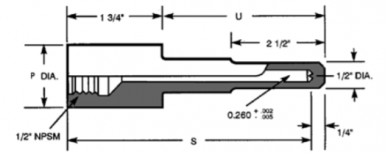
A thermometer with an NPT male thread is ideal for use in a thermowell with an NPSM female thread. This pairing optimizes heat transfer, facilitates maintenance and replacement, and gives users more choices.
Thermowells protect temperature measuring instrumentation from harsh, viscous, and corrosive media as well as from pressure and velocity. They also make it easier to replace and test the instrument without disrupting the process.

The standard practice at WIKA USA is to use ½-inch internal NPSM threads on thermowells, such as this TW.SW2R socket-weld thermowell.
The effectiveness of a thermometer inside a thermowell will largely depend on the amount of contact between the two pieces of equipment. Ill-fitting and inadequate connections reduce the heat-transfer process, which negatively impacts temperature measurements. For this and other reasons, the standard practice at WIKA USA is to use ½-inch female (internal) NPSM threads on thermowells in combination with a ½-inch NPT male (external) thread on a bimetal thermometer
NPT vs. NPSM Threads
There are many thread standards and varieties for pipes and connectors. For thermowells in the U.S. and Canada, these are the two main types of threads:
- NPT – American National Standard Pipe Tapered thread. This type creates a pressure-tight seal, which occurs when the male and female NPT threads compress and tighten.
- NPSM – American National Standard Pipe Straight Mechanical Joint thread. This type creates a non-pressure tight connection in applications that are not subject to internal pressures.
Many applications use the same type of male and female threaded connectors. However, WIKA USA recommends the use of thermowells with NPSM threads when the mating thermometers come with an NPT thread. Our experts have found that this pairing is a best practice in temperature measurements.
Comparing NPT and NPSM Threads
Both NPT and NPSM connectors have the same number of threads per inch, and the angle of each thread is 60 degrees. (BSPT, or British Standard Pipe Thread, connections have a thread angle of 55 degrees.) The obvious difference between NPT and NPSM, as their names indicate, is that the former is tapered (slightly conical) while the latter is straight (parallel).
So, why use a tapered male fitting together with a parallel female connector? Wouldn’t they bind? Wouldn’t the fit be awkward? The answer to the last two questions is “no.” As for the first question, WIKA USA makes it a standard practice due to several advantages.
Advantages of the NPSM Connection in a Thermowell
WIKA USA prefers using a NPSM connector in thermowells for the following three reasons:
- The thermometer tip makes close-to-full physical contact with the bottom of the thermowell. With the thermometer stem almost bottoming out, heat transfer is optimal from the process media through the thermowell to the measuring instrument. Better heat transfer translates into faster response times and more accurate temperature readings.
- The combination of male NPT and female NPSM connectors creates a looser fit, which prevents fusing. When NPT-to-NPT connectors are tightened, sometimes the result is a “cold weld.” This inadvertent fusion makes it very difficult to remove the thermometer from the thermowell for maintenance, calibration, or replacement.
- The user has more choices. A female NPSM connection can accept either an NPT or NPS (American National Standard Pipe Straight thread) measuring instrumentation. If a thermowell had a tapered thread, it would not be able to accept a straight thermometer stem. However, even though a female NPSM connection is WIKA USA’s standard, thermowells with NPT threads are available as an option
Since there is no internal pressure inside a thermowell, having an internal NPSM thread confers several advantages and no disadvantages when measuring temperature in challenging conditions.
For more information about thermowells, thread types, and which ones are best suited for your applications, contact the temperature measurement specialists at WIKA USA.


this article was so helpful… thank you so much
Really would like the opportunity to work for this company I have drive and people skills that I feel like will get me a long way
Hi Hodari, thank you for your interest in working for WIKA. Please take a look at our current job listings here.